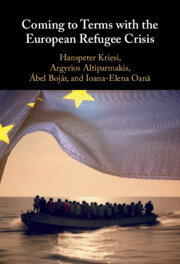Figures
1.1The analytical building blocks of the theoretical framework
4.1Refugee crises in Europe: number of asylum requests in the EU and in Germany, 1982–2020, in thousands
4.2Monthly submissions of asylum requests in 2010–2019 as a percentage of the population
4.3Asylum seekers and arrivals in Greece as a percentage of the population (arrivals are three-month rolling averages)
4.4Number of asylum seekers and arrivals in Italy as a percentage of the population
4.5Salience of immigration in national publics: Google trends and share of Eurobarometer respondents who consider immigration to be one of the most important issues
4.6Political pressure: radical right vote shares by country, monthly vote intentions
5.1Development of politicization of the policy response during the refugee crisis at the EU and national levels. (a) Sum of national politicization: smoothed curves; (b) average of national politicization: smoothed curves
5.2Starting dates of the episodes in relation to problem pressure (asylum requests) and political pressure (public salience). (a) Frontline states; (b) transit states; (c) open destination states; (d) closed destination states (smoothed curves).
5.3Thematic focus of policymaking at the EU level: development of issue-specific politicization over time
5.5Share of border control actions by member state type and crisis period: percentages
6.1Average level of conflict intensity by country and broad actor types as instigators (a) and targets (b)
6.2Conflict scores for the four dominant conflict lines in the policy episodes
6.3Relative strength of conflict lines in policy episodes (by country type: frontline states, transit states, open destination states, closed destination states)
6.4Problem pressure, demand-side salience, and political pressure by conflict type
6.5Average levels of politicization and support behind government policies across the policy episodes
7.1Overall configuration of conflict structure at the EU level: MDS result
7.2Politicization and its components by actor types: standardized averages. (a) Actor types; (b) actor camps
7.3Politicization by broad actor camps and episodes: standardized averages
7.5The conflict structures at the EU level, by phase: MDS results
8.1The sources of intragovernment conflicts in the refugee crisis
8.3Ideological position (a) and distance (b) of governing coalitions in the refugee crisis
8.6Relationship between the content of the conflict and their partisan source
9.1Differences in percentage use of frames between mainstream right and radical right actors
9.3Differences in percentage usage of themes between mainstream right and radical right actors
9.5MDS configuration of parties’ relative proximity based on their use of frames
9.6MDS configuration of parties’ relative proximity based on their use of themes
10.2The impact of problem pressure across country types, episode types, and crisis periods
10.3The impact of political pressure across country types, episode types, and crisis periods
11.4Politicization of German episodes and EU episodes concerning asylum rules
13.1Policy-specific distribution of support, by country type. (a) Relocation quota; (b) Dublin regulation; (c) EBCG; (d) externalization
13.2Transnational conflict configuration according to citizens’ policy positions in the refugee crisis: MDS solution
13.3Development of immigration attitudes over time, mean factor scores by country
13.4Policy support by immigration attitudes. (a) Relocation quota: support; (b) Dublin regulation; (c) external border control; (d) internal border control; (e) externalization
13.5Policy support by party family. (a) Relocation quota; (b) Dublin regulation
13.6Transnational and domestic conflict configurations according to citizens’ policy positions in the refugee crisis: OLS regression coefficients
13.7The effect of immigration attitudes on the six policy positions in frontline states and other states
13.8Transnational and domestic conflict configurations according to citizens’ policy positions (p = pro/c = contra immigration) in the refugee crisis and immigration attitudes: MDS solution
13.9Transnational and domestic conflict configurations according to citizens’ policy positions in the refugee crisis and party families: MDS solution
14.1The salience of immigration, measured as a share of immigration issues over total issues
14.2Average weighted position of each party-system across time
14.3Interparty salience for each party family on immigration issues per election, 2002–2020
14.4Share of core sentences of each party that refer to immigration, 2002–2019
14.5Average party family positions on immigration per election, 2002–2019

